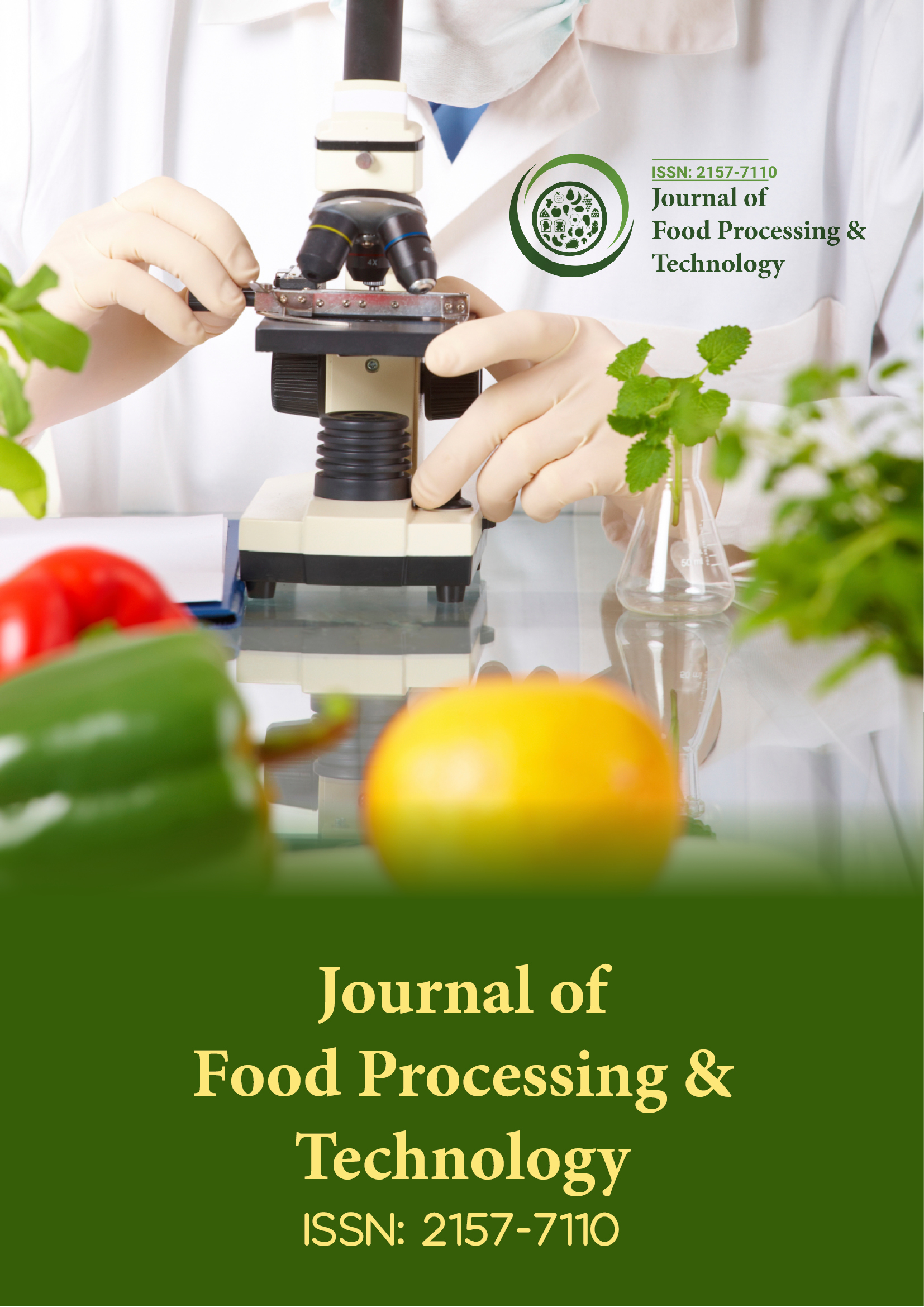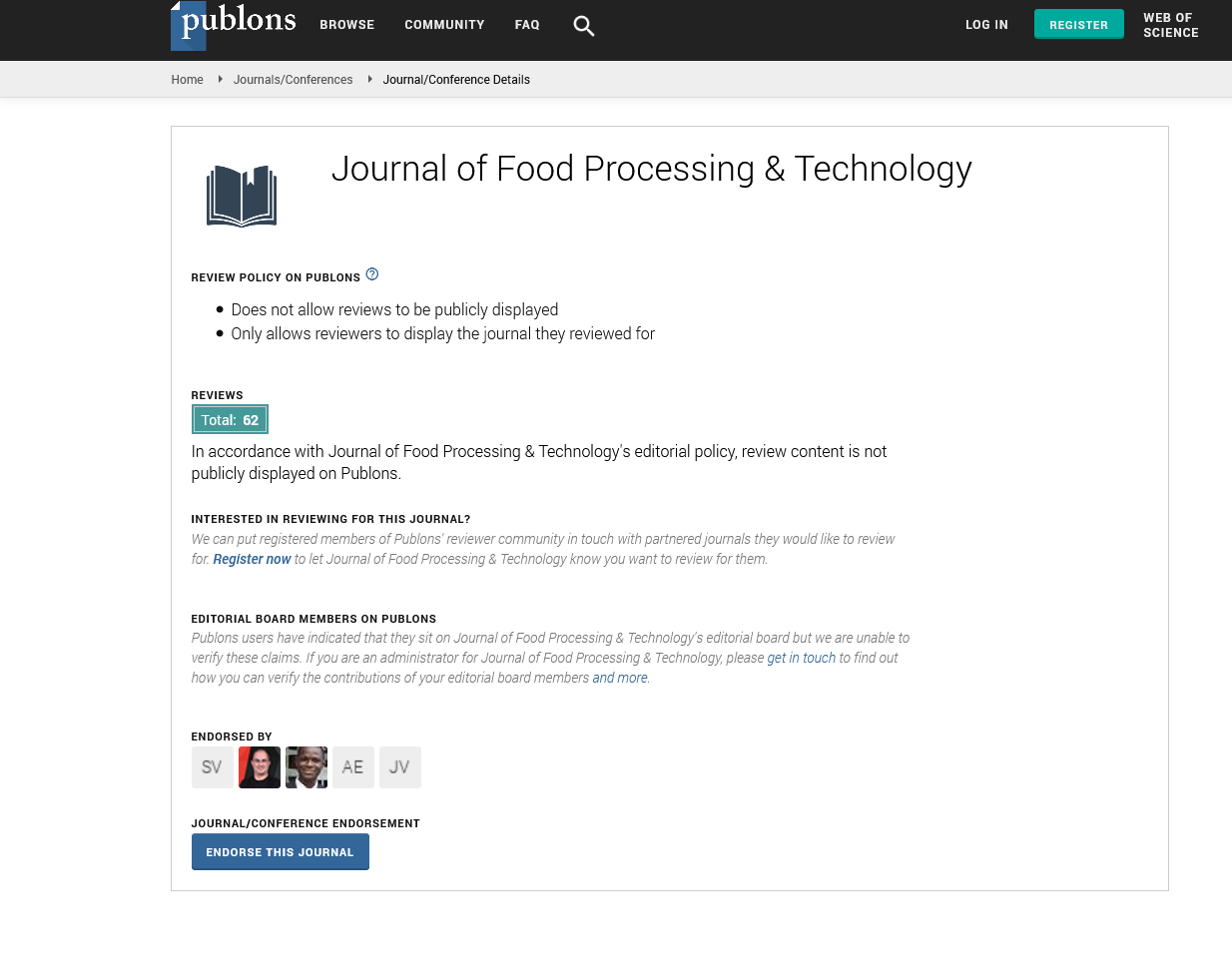Indexed In
- Genamics JournalSeek
- Academic Keys
- JournalTOCs
- China National Knowledge Infrastructure (CNKI)
- Access to Global Online Research in Agriculture (AGORA)
- Centre for Agriculture and Biosciences International (CABI)
- RefSeek
- Directory of Research Journal Indexing (DRJI)
- Hamdard University
- EBSCO A-Z
- OCLC- WorldCat
- Scholarsteer
- SWB online catalog
- Publons
- Euro Pub
- Google Scholar
Useful Links
Share This Page
Journal Flyer

Open Access Journals
- Agri and Aquaculture
- Biochemistry
- Bioinformatics & Systems Biology
- Business & Management
- Chemistry
- Clinical Sciences
- Engineering
- Food & Nutrition
- General Science
- Genetics & Molecular Biology
- Immunology & Microbiology
- Medical Sciences
- Neuroscience & Psychology
- Nursing & Health Care
- Pharmaceutical Sciences
Research Article - (2022) Volume 13, Issue 7
Efficacy Moisture Sorption Isotherms and Net Isosteric Heat of Sorption for Argan Leaves (Argania spinosa (L) Skeels)
Fz Ennoukh1*, Khamsa Sghaier2* and Rahma Bchitou1*2Department of Process Engineering and Environment Sciences, Université de Gabès, Zrig Eddakhlania, Tunisia
Received: 22-Oct-2020, Manuscript No. JFPT-22-003-PreQc-22; Editor assigned: 26-Oct-2020, Pre QC No. JFPT-22-003-PreQc-22 (PQ); Reviewed: 09-Nov-2020, QC No. JFPT-22-003-PreQc-22; Revised: 16-Nov-2020, Manuscript No. JFPT-22-003-PreQc-22 (R); Published: 23-Nov-2020
Abstract
The objective of this work was to determine moisture desorption and adsorption isotherms of leaves Argania spinosa (L) Skeels. The equilibrium moisture content of argan leaves was measured using the static gravimetric method at three temperatures (30°C, 40°C and 50°C) and in wide range of water activity (0.07–0.898). Eight different mathematical sorption models have been fitted to the experimental data. The Peleg model represent sorption curve more adequately. The parameters of Peleg have been estimated both by direct and indirect regression methods. The net isosteric heats of desorption and adsorption was determined from sorption isotherms using the Clausiuse Clapeyron equation and was decreased as moisture content increased. The differential enthalpy and entropy decreased as moisture content increased and were adequately described by a polynomial function. The enthalpy-entropy compensation theory was satisfied by a plot of differential heat versus entropy. The comparison of A.spinosa sorption isotherms and thermodynamic properties.
Keywords
Argania spinosa leaves; Equilibrium moisture sorption; Isosteric heat of sorption; Sorption isotherms
Introduction
The Argan tree Argania spinosa (L) Skeels, member of the family Sapotaceae, is a tropical plant, grows especially in the south region of Morocco. Argan tree is known by Argan oil, obtained from the pit of Argania spinosa . This oil became famous worldwide for its remarkable properties and wonderful taste [1]. Argania spinosa is also used in cosmetics domain, and their industrial use is being actively investigations. It’s considered one of the potential natural antioxidant sources because of its phenolic content which was not restricted by argan oil, but also by its leaves.
Historically, the argan leaves has been used to treat gastritis, diarrhoea, fever and headaches. In poultice, leaves treat sprains, infected wounds and scabies animals [2,3]. Agan leaves have recently been used in cosmetics due to their high content of flavonoids (mainly quercetin and myricetin derivatives), in addition the essential oils of argan leaves are also highly valuable derivatives, due to their pharmacological properties. For this purpose, it is indispensable to stabilize the leaves by a dehydration process to extend their shelf life and preserve their active constituents.
During storage, the quality of the leaves can be thereby seriously degraded, some physical, chemical and biological reactions may occur, and can give birth to microorganisms [4]. These reactions are particularly influenced by moisture content of the material and relative humidity of ambient air. It therefore becomes necessary to knowledge the moisture sorption isotherms because, it can help describe how actively water is bound to a solid, and to predict the storage stability of food products.
The aims of this paper were: to determinate experimentally the desorption and the adsorption isotherms argan leaves at 30°C, 40°C and 50°C, to mathematically model the experimental data and to calculate the net isosteric heats of desorption and adsorption of the argan leaves for different moisture contents. The mathematical examination is performed in order to report which model best fits the experimental data for the studied range of temperatures and water activity [5,6].
Materials and Methods
Experimental
Samples used for the sorption experiments are leaves of Argania spinosa (L) Skeels, collected in the south of Morocco (region Taroudant).
Methods
The equilibrium moisture content of Argania spinosa leaves at 30°C, 40°C, and 50°C were measured by using by gravimetric method [7,8]. This method requires a lot of time for reaching the hygroscopic equilibrium; it has the advantage of presenting a more restricted domain of moisture content variation.
Experimental procedure
A six saturated salt solutions: KOH, MgCl2.6H2O, K2CO3, KI, NaCl and BaCl2.6H2O, were prepared by solubilizing an appropriate amount of salt in distilled water at each temperature, covering a water activity range of 0.07-0.898 [9,10].
These solutions were placed inside hermetic jars with an insulted lid. Every glass jar was quarter filled with the saturated salt solution. Duplicated samples each of 0.5 g (±0.0001 g) for desorption and 0.2 g (±0.0001 g) for adsorption were weighed and placed into the glass jars. These hermetic jars were placed in a controlled oven temperature 30°C, 40°C and 50°C for equilibration [11].
Finally, the argan leaves samples were measured each two days utilizing a Metteler AT 400 balance ( ± 0.0001g), until the point that they achieved a consistent weight. The whole procedure was rehashed three times for every temperature [12,13].
The equilibrium moisture content (EMC=Xeq) of each example was resolved in a drying oven at 105°C for 24 hr. Moisture content was expressed on a dry basis (kg water/kgdb).The difference of mass before (ms) and after (mh) drying in the oven allows the determination of the product’s moisture content Eq. (1)

The result of this experiment is shown in Table 1.
| Isotherme at 30°C | Isotherme at 40°C | Isotherme at 50°C | ||||||
|---|---|---|---|---|---|---|---|---|
| Xeq (kg/kg db) | Xeq (kg/kg db) | Xeq (kg/kg db) | ||||||
| aw | Ads | Des | aw | Ads | Des | aw | Ads | Des |
| 0.0738 | 0,0013 | 0,0014 | 0.0626 | 0,0011 | 0,0013 | 0.0572 | 0,0009 | 0,001 |
| 0.3238 | 0,0023 | 0,0027 | 0.3159 | 0,0021 | 0,0025 | 0.3054 | 0,0012 | 0,0015 |
| 0.4317 | 0,0035 | 0,0038 | 0.423 | 0,0030 | 0,0033 | 0.4091 | 0,0022 | 0,0028 |
| 0.6789 | 0,0040 | 0,0043 | 0,6609 | 0,0030 | 0,0034 | 0,6449 | 0,0030 | 0,0031 |
| 0.751 | 0,0054 | 0,0060 | 0.747 | 0,0041 | 0,0046 | 0.744 | 0,0035 | 0,0038 |
| 0.898 | 0,0108 | 0,0130 | 0.891 | 0,0120 | 0,0122 | 0.8823 | 0,0099 | 0,0102 |
Table 1: Adsorption and desorption equilibrium moisture contents of argan leaves at different water activities and temperatures.
Data analysis
Mathematical description of sorption isotherms: The experimental sorption curves were studied using eight different mathematical models Table 2, among many in the literature [14]. The curve fitting and regression analysis were performed using MATLAB R2013b. The best fit was chosen according to the minimum standard error of the fit RMSE Eq. (2), and the maximum degrees of correlation coefficient R2 Eq. (2).
| Modèles | Equations | Références |
|---|---|---|
| GAB |  |
[14] |
| Henderson |  |
[15] |
| Halsey |  |
[16] |
| Chung-Pfost |  |
[17] |
| Oswin |  |
[18] |
| Smith |  |
[19] |
| BET |  |
[20] |
| Peleg |  |
[21] |
Table 2: The models applied to the experimental sorption data of argan leaves.

Where: n is the number of data points, Xical and Xiexp are predicted and experimental values, respectively (Table 2).
Determination of net isosteric heat of sorption
The net isosteric heat of sorption Argania spinosa leaves was determined by using Eq. (7), which is derived from the CLAUSIUSCLAPEYRON equation, for fixed moisture contents [15,16].

Where aw, is the water activity (dimensionless), Qst is the net isosteric heat of sorption (kJ/mol), T is the absolute temperature (K), R is the universal gas constant (kJ/mol K) and K is constant.
The values of ln (aw) could be plotted against (1/T). The net isosteric heat of desorption values were determined from the slope of the straight (Qst/R).
This procedure is repeated for several equilibrium moisture content values determined by the best fit desorption model [17,18].
Results and Discussion
Sorption isotherm models
The argan leaves used in the sorption was growen in the Taroudant regions south of Morocco. The hygroscopic equilibrium of argan leaves is achieved respectively after 12 days for desorption and 10 days for adsorption.
The drying rate curves for argan leaves at the three temperatures 30°C, 40°C and 50°C are shown in Figure 1.

Figure 1: Sorption isotherms of argan leaves at 30°C, 40°C and 50°C. Note: T505°C0°C.
T505°C0°C.
The sorption isotherms have a sigmoidal shape and they are of type II according to Brunauer’s classification,in agreement with the behavior of other medicinal and aromatic plants and food products. This type of isotherm is characterised by its progressive thickening of adsorbed layer into high water activity value domain. Similar results were observed in several other studies such as lemon balm leave at a temperature of 25°C and a relative humidity between 0 and 95% [19] and olive leaves at 40°C, 50°C and 60°C in a relative humidity range of between 0.0572 and 0.898 [20].
The impact of temperature shift on the desorption and the adsorption argan leaves isotherms (Figure 1) demonstrate that for the same value of water activity, moisture content at equilibrium decreases with increasing temperature. This might be clarified by the higher excitation state of water molecules at higher temperature, thus decreasing the attracting forces between them [21].
From Figure 2, we note that at same relative constant humidity the water, the equilibrium moisture content (EMC=Xeq) of the desorption isotherm is higher than that of adsorption. Hysteresis phenomenon existed, even if he is low; this may be due to changes in the structure and porosity.

Figure 2: Sorption hysteresis phenomenon of argan leaves at 30°C, 40°C and 50°C. Note:
Modelling of sorption experimental data
The experimental data of desorption and adsorption curves of argan leaves was fitted to eight models. The results of the Peleg and Gab models had highest values of the correlation coefficient (R2) and lowest values of standard error (RMSE) values compared to the other models.
In Figure 3, the fitting of the sorption isotherms with the Peleg’s model is also shown. A good agreement between experimental and predicted data was found. Peleg’s model has also been successfully applied to several aromatic and medicinal plants like olive leaves [22,23] and orange leaves [24].

Figure 3: Experimental data and calculated by Peleg model and GAB model of sorption isotherms at 30, 40 and 50°C.
Note: ( — ) GAB.
( — ) GAB.
Isosteric heat of sorption
The estimations of isosteric heat of sorption Qst; are figured from the equilibrium data at various temperatures using Clausius- Clapeyron equation Figure 4.

Figure 4: Adsorption isosteres for argon leaves. Note: Xeq=0,01,
Xeq=0,01,  Xeq=0,025.
Xeq=0,025.
The examination of Figure 5, demonstrates that the net isosteric heat of desorption is more prominent than that of adsorption.

Figure 5: Isosteric heat of sorption of argon leaves. Note: T30°C,
T30°C, 
This result indicates that the energy demanded in the desorption process is greater than that in the adsorption process as stated by [25]. It was also noted that the qst increases with decrease in water content, this explained by the greater resistance to the movement of water from interior to the surface of the products [26-28].
The net isosteric heat of adsorption and desorption of water in argan leaves can be expressed mathematically by an exponential function of the moisture content for the adsorption and desorption:
For desorption: r=0, 9995; S=0, 0015
E1: Qst(desorption)=0.1058 exp(337.786 Xeq)+0.0903 exp(- 41.8295 Xeq)
For adsorption: r=0,999; S=0, 0003
E2: Qst(adsorption)= -0.0017+0.0782 exp(1035.114 Xeq)+0.0348 exp(-193.0509Xeq).
Conclusion
The sorption isotherms of argan leaves were determined by the static gravimetric method in the temperature range of 30°C to 50°C. These isotherms have a sigmoidal appearance of a type II according to the BET classification.
In order to find the most suitable correlation to describe sorption isotherms of argan leaves, eight mathematical models were tested. Analysis of the statistical parameters revealed that the Peleg model is the best model to describe the isotherms of argan leaves at 30°C and 50°C and the model of GAB at 40°C in adsorption. As for desorption isotherms Peleg’s model was the most adequate model for describing the experimental data. Net isosteric heat of sorption was determined from sorption isotherms of argan leaves and it was found that the net isosteric heat of desorption is greater than that of adsorption.
REFERENCES
- Jamali M, Kouhila L, Mohammed A, Idlimam A, Lamharrar A. Moisture adsorption-desorption isotherms of Citrus reticulata leaves at three temperatures. J Food Eng. 2006; 71-78.
- Argyropoulos D, Müllera J. Effect of convective drying on quality of lemon balm (Melissa officinalis L). Procedia Food Sci. 2011; 1: 1932-1939.
- Mohamed L, Kouhila M, Lahsasni S, Jamali A, Idlimam A, Rhazi M, Aghfir M, Mahrouz M. Equilibrium moisture content and heat of sorption of Gelidiumsesquipedale. J Stored Prod Res. 2004
- Boudhrioua N, Bahloul N, Kouhila M, Kechaou N. Sorption isotherms andisosteric heats of olive leaves (Chemlali variety): experimental and mathematical investigations. Food Bioprod Process. 2008; 86:167–175.
- Brunauer S, Emmett PH, Teiller E. Adsorption of gases in multimolecularlayers. J Am Chem Soc. 1938; 60:309–319.
- Bahloul N, Boudhrioua N, Kechaou N. Moisture desorption–adsorptionisotherms and isosteric heats of sorption of Tunisian olive leaves (Oleaeuropaea L). Ind Crops Prod. 2008;28:162–176.
- Cenkowski S, Jayas DS, Hao D. Latent heat of vaporization forselected foods and crops. Can Agric Eng. 1992;34: 281–286.
- CR Oswin. The kinetics of package life. III. The isotherm. J Chem Ind. 1946;65:419–423.
- Van den Berg. Description of water activity of food engineering purposes by means of the GAB model of sorption. Eng Food. New York. 1984.
- Menezes De. Cardiovasular effects induced by Cymbopogon winterianus essential oil in rats: involvement of calcium channels and vagal pathway. J Pharm Pharmacol. 2010; 62:215–221.
[Crossref] [Google Scholar] [PubMed]
- ElBabili F, Bouajila J, Fouraste I, Valentin A, Mauret S, Moulis C. Chemical study, antimalarial and antioxidant activities,and cytotoxicity to human breast cancer cells (MCF7)of Argania spinosa.Int J Phytomedicine. 2010;17:157–16.
[Crossref] [Google Scholar] [PubMed]
- Garcia-Perez JV, Carcel JA, Clemente G, Mulet A. Water sorptionisotherms for lemon peel at different temperatures and isosteric heats. Food Sci Technol. 2008;41:18–25.
- Halsey GB. Physical adsorption on non-uniform surfaces. J Chem Phys. 1948;16:931–937.
- Iglesias HA, Chirife J. An alternative to the Guggenheim Anderson and de Boer model for mathematical description of moisture sorption isotherms of foods. Food Res Int. 1995 ;28(3):317–321.
- Koch C. Efficacy of anise oil, dwarf-pine oil and chamomile oil against thymidine-kinase-positive and thymidinekinase- negative herpesviruses. J Pharm Pharmacol. 2008;60:1545–1550.
- KammounBejar A, BoudhriouaMihoubi N, Kechaou N. Moisture sorption isotherms – Experimental and mathematical investigations of orange (Citrus sinensis) peel and leaves. Food Chem. 2012;32(4): 1728-1735.
- Lang KW, Mccune TD, Steinberg MP. A proximity equilibration cell for rapid determination of sorption isotherms. J Food Sci. 1981;46:936.
- Labuza TP, Khanawe A, Chen JY. Effect of temperature on the moisturesorption isotherms and water activity shift of two dehydrated foods. J Food Sci. 1985;50:385-391.
- Peleg M. Assessment of a semi-empirical four parameter general model for sigmoid moisture sorption isotherms. J Food Process Eng. 1993;16:21–37.
- Naji A, Idlimam A, Kouhila M. Sorption isotherms and thermodynamic properties of powdered milk. Chem Eng Comm. 2010;197(8):1109-1125.
- Pauly G. Cosmetic and/or dermopharmaceutical preparations containing leaf extract of the plant Argania spinosa. 2006.
- Sousa OV. Antinociceptive and anti-inflammatory effects of the essential oil from Eremanthuserythropappus leaves. J Pharm Pharmacol. 2008;60:771–777.
[Crossref] [Google Scholar] [PubMed]
- Henderson SM . A basic concept of equilibrium moisture. Agric Eng.1952;33:29-32
- Simal S, Femenia A, Castell-Palou A, Rossello C. Water desorptionthermodynamic properties of pineapple. J Food Eng. 2007;80:1293–1301.
- Smith SE. The sorption of water vapour by high polymers. J Am Soc. 1947;69:646
- Brunauer S, Deming LS, Deming WE, Teller E. On a theory of the Van der Waals adsorption of gases. J Am Chem Soc. 1932;62:1723–1732.
- Chung S. Adsorption and desorption of water vapor by cereal grains andtheir products. Part I. Heat and free energy changes of adsorption and desorption. Transaction of the ASEA. 1967;10:549–551.
[Crossref]
- Yan Z, Sousa GM, Oliveira F. Effect of temperature andinitial moisture content on sorption isotherms of banana dried bytunnel drier. Int J Food Sci Tech. 2008;43(8):1430-1436.
Citation: Ennoukh Fz, Sghaier K, Bchitou R (2022) Efficacy Moisture Sorption Isotherms and Net Isosteric Heat of Sorption for Argan Leaves (Argania spinosa (L) Skeels). J Food Process Technol. 13:942.
Copyright: © 2022 Ennoukh F, et al. This is an open-access article distributed under the terms of the Creative Commons Attribution License, which permits unrestricted use, distribution, and reproduction in any medium, provided the original author and source are credited.


